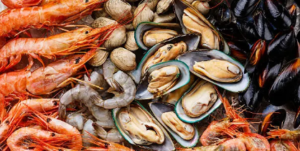High-quality frozen seafood can be an excellent option for people with limited access to fresh fish. It can also take the guesswork out of weekly meal planning. Online seafood stores can offer a wide range of options, from wild-caught whole fish to fillets of farm-raised fish.
 Blue Circle sources its fish from fishermen who meet its standards for sustainability and uses third-party audits to ensure labelling accuracy. It also offers a variety of convenient kits and themed dinners. For more frozen seafood online, click here.
Blue Circle sources its fish from fishermen who meet its standards for sustainability and uses third-party audits to ensure labelling accuracy. It also offers a variety of convenient kits and themed dinners. For more frozen seafood online, click here.
Longer Shelf Life
Frozen seafood has a much longer shelf life than fresh seafood. It can last months when stored correctly. It makes it easy for consumers to pre-plan meals, avoid food waste, and enjoy a variety of healthy seafood recipes. Additionally, the freezing process helps preserve nutrients that may otherwise be lost during handling and storage.
Most frozen fish is caught and frozen directly after harvesting, which retains its natural flavour. In addition, many seafood delivery services offer wild-caught and sustainably sourced fish free of artificial preservatives and exploitative practices.
Another advantage of frozen seafood is that it’s often pre-cleaned and ready to cook. It saves time on meal preparation and eliminates the need for additional steps like deboning and cleaning. In addition, the variety of frozen fish available allows for experimentation with different cuisines and cooking methods. Moreover, the versatility of these foods makes them an excellent option for individuals with limited kitchen space.
Convenience
Seafood lovers can now access a wider variety of fresh and frozen fish varieties thanks to advances in freezing technologies. Whether you are looking for locally sourced salmon or cod or something more exotic like barramundi from Australia, you can deliver it right to your door. Many online seafood retailers offer temperature-controlled packaging and sustainable fish species. For more frozen seafood online, click here.
Frozen food products are less expensive than fresh seafood, especially in bulk. It is because most online seafood companies begin shipping their fish straight from their boats, eliminating many intermediaries and reducing transportation costs.
Moreover, most types of seafood freeze well without losing much in terms of flavour and texture. In addition, buying in bulk reduces food waste, which is a severe problem that not only has economic implications but also contributes to environmental degradation. Moreover, it is essential to note that an excellent online retailer will provide detailed information on their fish and where it comes from.
Transparency
Seafood consumers are increasingly interested in the traceability of their purchases. Companies offering seafood online often include point-of-sale storytelling about a product’s origin, and some provide end-to-end traceability through interoperable electronic data transmission throughout the supply chain (Badia-Melisa and others, 2015).
Some retailers also make public traceability commitments. For example, the retail grocer Albertsons Companies (Boise, Idaho, U.S.A.) requires that its private-brand seafood products come from fisheries and farms whose sustainability practices meet specific criteria, including sustainable farming and fishing methods. In addition, the company’s seafood is certified by the Marine Stewardship Council.
Some seafood companies use gill tags containing unique identifiers to track individual products. These identifiers stay attached to the product as it moves through the supply chain and can be accessed by consumers using a smartphone app or a website provided by the seafood company. In addition, some companies rely on 3rd-party traceability software solutions that link vital data elements (KDEs) with unique identifiers. For more frozen seafood online, click here.
Cost
Seafood can be expensive in grocery stores, but online seafood delivery services provide better quality for a lower price. These companies also benefit from lowering the environmental impact of seafood production. Fresh fish must be shipped quickly to customers, requiring air travel and fuel. Frozen seafood, on the other hand, can be sent by train and ship, which reduces carbon emissions and transportation costs.
Some of the best-frozen seafood comes from companies that work with sustainable fishermen and follow fair trade practices. Citarella, for example, sells a wide range of seafood options from New York City’s Fulton Fish Market, including swordfish, mussels and snapper.
Another option is to get the gourmet lobster you’d find in restaurants delivered right to your door with a seafood subscription from Thrive Market. This membership-based grocer charges a $60 annual fee, but you’ll spend less than in a store on one-time orders of frozen seafood like its private-label wild-caught salmon and black cod.